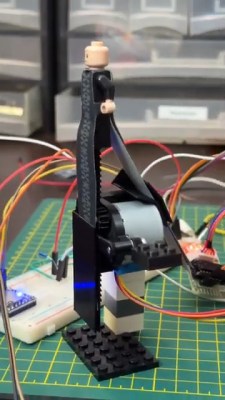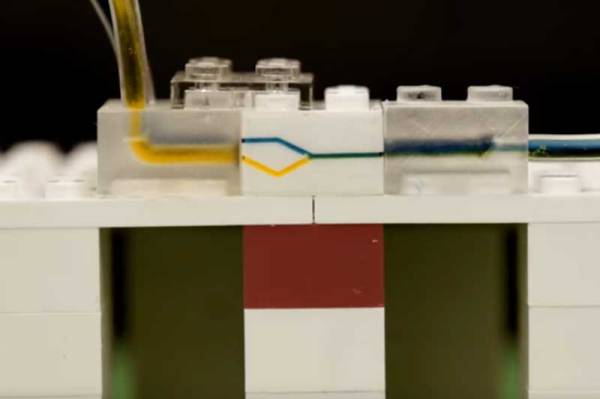As any good hacker (or scientist) knows, sometimes you find the tools you need in unexpected places. For one group of MIT scientists, that place is a box of Lego. Graduate student [Crystal Owens] was looking for new ways to make a cheap, simple microfluidics kit. This technique uses the flow of small amounts of liquid to do things like sort cells, test the purity of liquids and much more. The existing lab tools aren’t cheap, but [Crystal] realized that Lego could do the same thing. By cutting channels into the flat surface of a Lego brick with a precise CNC machine and covering the side of the brick with glass, she was able to create microfluidic tools like mixers, drop makers and others. To create a fluid resistor, she made the channel smaller. To create a larger microfluidic system, she mounted the blocks next to each other so the channels connected. The tiny gap between blocks (about 100 to 500 microns) was dealt with by adding an O-ring to the end of each of channel. Line up several of these bricks, and you have a complete microfluidic system in a few blocks, and a lab that only costs a few dollars.
Optics Laboratory Made From LEGO
16A lot of engineers, scientists, builders, makers, and hackers got their start as children with LEGO. Putting those bricks together, whether following the instructions or not, really brings out the imagination. It’s not surprising that some people grow up and still use LEGO in their projects, like [Steve] who has used LEGO to build an optics lab with a laser beam splitter.
[Steve] started this project by salvaging parts from a broken computer projector. Some of the parts were scorched beyond repair, but he did find some lenses and mirrors and a mystery glass cube. It turns out that this cube is a dichroic prism which is used for combining images from the different LCD screens in the projector, but with the right LEGO bricks it can also be used for splitting a laser beam.
The cube was set on a LEGO rotating piece to demonstrate how it can split the laser at certain angles. LEGO purists might be upset at the Erector set that was snuck into this project, but this was necessary to hold up the laser pointer. This is a great use of these building blocks though, and [Steve] finally has his optics lab that he’s wanted to build for a while. If that doesn’t scratch your LEGO itch, we’ve also featured this LEGO lab which was built to measure the Planck constant.
Lego Mindstorms Used To Automate Tedious Laboratory Tasks

Modern society owes so much to medical research, though what happens behind the scenes in a laboratory is usually far less than glamorous. A group of scientists at the University of Cambridge are working to develop synthetic bone tissue, but the process to create the samples used in the study is incredibly tedious.
To make the bones, a substructure must be dipped in a mixture of calcium and protein, rinsed, then dipped in a mixture of phosphate and protein…hundreds and hundreds of times. Equipment that can automate the process is available but very cost prohibitive, so the scientists did what they do best and built a set of robots to do the work for them.
Their new bone manufacturing setup was constructed using Lego Mindstorm kits, which were a perfect solution to their problem in several ways. The kits are relatively cheap, easy to construct, easy to program, and able to perform the same function precisely for days on end.
Now instead of burning time manually creating synthetic bone samples, the group can focus on the more important facets of their research.
Continue reading to see a video presented at the 2012 Google Science Fair, showing how everything came together for the crew at Cambridge.
[via Make]
Continue reading “Lego Mindstorms Used To Automate Tedious Laboratory Tasks”
There Are Better Lego-Compatible Universal Joints Out There
Lego’s Technic line features all kinds of mechanical devices, from cogs to gears to chains and even pneumatic components. However, the vast majority of these components are made out of plastic and are only capable of toy-like levels of performance. In the competitive world of Lego YouTube, builders often push these parts to their limits, breaking them more often than you might think. To that end, [Brick Experiment Channel] has been investigating stouter Lego-compatible universal joints from a variety of third-party manufacturers.
The video starts with a simple demonstration, showing that a Lego universal joint pops apart at just 0.4 Nm of torque. It’s no surprise, given it relies on tiny plastic pins in snap-fit joints. However, this means that it’s not that hard to build a stronger universal joint to outperform the stock parts.
The video steps through a range of other options available on the market. For example, CaDA builds a universal joint using aluminium sleeves, a copper center, and steel pins to join everything together. It’s so strong that the plastic Lego axles fail long before the joint does. Tested with third-party aluminum axles, it eventually fails at 2.3 Nm of torque when the aluminum sleeve snaps. An all-steel joint from MTP goes even harder, eventually stripping out its axle mount at 4 Nm. The rest of the video goes on to explore angular performance, size, and other design features.
It’s fair to say that if you’re swapping out universal joints and axles for aluminum steel parts, you’re not really playing with Lego anymore. At the same time, it’s neat that there exists a sort of defacto standard kit for mechanical experimentation that is now being expanded upon with stronger components. Video after the break.
Continue reading “There Are Better Lego-Compatible Universal Joints Out There”
Hackaday Podcast Episode 292: Stainless Steel Benchies, Lego Turing Machines, And A Digital Camera Made Of Pure DIY
Here we are in October, improbably enough, and while the leaves start to fall as the goblins begin to gather, Elliot and Dan took a break from the madness to talk about all the wonderful hacks that graced our pages this week. If there was a theme this week, it was long-term projects, like the multiple years one hacker spent going down dead ends in the quest for DIY metal 3D printing. Not to be outdone, another hacker spent seven years building a mirrorless digital camera that looks like a commercial product. And getting a solderless PCB to do the blinkenlight thing took a long time too.
Looking to eliminate stringing in your 3D prints? Then you’ll want to avoid the “pause and attach” approach, which intentionally creates strings in your prints. Wondering if you can 3D print bearings? You can, but you probably shouldn’t unless you have a particular use in mind. And what happens when you have an infinitely large supply of Lego? Why, you build a Turing machine on steroids, of course.
Finally, we take a look at this week’s “Can’t-Miss” articles with a look into plastic recycling and why we can’t have nice things yet, and we take a trip out into orbit and examine the ins and outs of Lagrange points.
And a little mea culpa from the editing desk: Sorry the podcast is coming out late this week. Audacity ate my files. If you’re ever in a similar circumstance, you can probably halfway save your bacon with audacity-project-tools. Ask me how I know.
A Throne For LEGO Baron Harkonnen
If you’re both a LEGO and a Dune fan, unless you’ve been living in a cave on Mars with your eyes shut and fingers in your ears, you’re probably aware that LEGO released a set for the royal Atreides ornithopter. The blades flap and everything. Anyway, it comes with several minifigures, including one that doesn’t quite fit with the others — a full-length Baron Harkonnen.
 Given that, [gorkyver] decided to create a throne for the Baron that he could rise from, just like in the movie, while delivering the iconic line. With no reference materials available other than pausing the movie, [gorkyver] created a throne from scratch in BrickLink Studio, which made it easy to generate both a parts list and step-by-step instructions.
Given that, [gorkyver] decided to create a throne for the Baron that he could rise from, just like in the movie, while delivering the iconic line. With no reference materials available other than pausing the movie, [gorkyver] created a throne from scratch in BrickLink Studio, which made it easy to generate both a parts list and step-by-step instructions.
At the heart of this build is an Arduino Nano, which takes input from the momentary push button and starts the show. The Baron slowly rises on a rack and spur gear connected to a stepper motor, and a DF Player Mini runs the audio through a 75 mm speaker.
Rather than just buying a big box store display case off of eBay, [gorkyver] recreated the skeleton in Fusion 360 and used a hairdryer to bend a sheet of PET-G around to enclose it. A couple of sweet adhesive graphics later, and it totally looks like a real set on display. Don’t miss the demo/build video after the break.
Did you hear? The European Space Agency printed some bricks out of meteorite dust, and there might be one on display near you.
LEGO Bricks: Now Out Of This World
Now the eyes of space explorers are turned once more towards the Moon, there are a whole host of new engineering challenges facing engineers working on lunar missions. One such challenge relates to how any proposed Moon base might be built, and as European Space Agency (ESA) researchers turn their mind to the problem they’ve taken a uniquely European approach. They’ve made some LEGO bricks.
Sadly lunar regolith is in short supply in Europe at the moment, so as a stand-in they’ve ground up a meteorite, mixed the powder with a polymer, and 3D printed their bricks. The LEGO write-up is a little long on frothy writing style and a little short on the science, but it seems that they clutch in exactly the same way as the official bricks from Billund, and can be assembled just as you would a normal set of bricks.
It’s with some regret that we have to concede that Europe’s off-planet outpost won’t be crewed by LEGO people in a base made from LEGO bricks, but we applaud them for doing this as a practical test given the limited supply of starter material. LEGO themselves have snagged some of them to display in a range of their flagship stores, so we hot-footed it down to London to catch some pictures. What we found is a single brick in a glass case, sadly looking very like any other 3D printed brick in a shiny grey medium. It’s probably the most expensive brick in the world though, so we doubt they’ll be available to buy any time soon.
If you’re hungry for more of all things LEGO, we can do no better than suggest a trip to the mother lode, in Billund, Denmark.

















